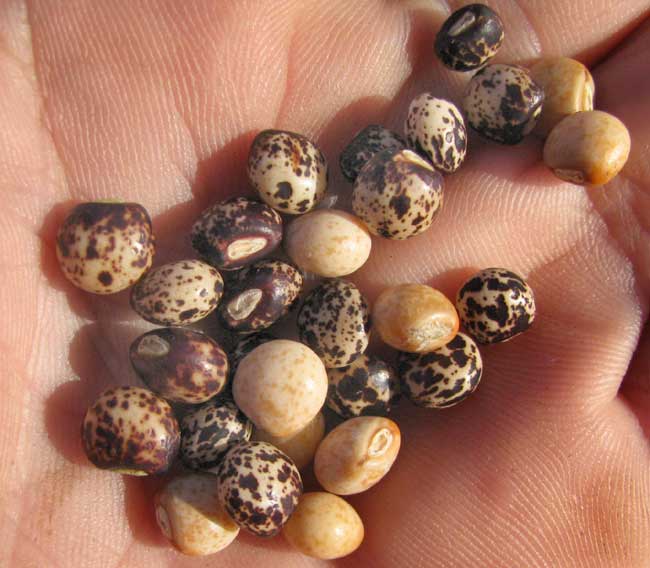Excerpts from Jim Conrad's
Naturalist Newsletter

from the January 9, 2011 Newsletter issued from Hacienda Chichen Resort beside Chichén Itzá Ruins, central Yucatán, MÉXICO; limestone bedrock, elevation ~39m (~128ft), ~N20.676°, ~W88.569°
MYSTERIOUS MAYA BEANS
The other day Wilfrido showed me a handful of beans he plans to sow in the milpa. You can see them above.
At first glance I thought they were some kind of pinto or kidney bean, or chickpea, but then he started telling me more about the plant. Beans are produced in pods borne not on twining vines, but on much-branching bushes that reach about ten feet tall. They're herbaceous bushes, though, growing that tall in a single season, then dying back after beans are produced.
Wilfrido called the beans Lentejas Mayas, but lentejas are lentils, and clearly these aren't what Northerners think of as lentils. He says that the beans are handed down from generation to generation of Maya farmer, so you don't buy them. They're strictly Maya beans.
If I can find someplace new to go, this spring I plan to move on, so I can't just wait to see the plant myself and use the flowers to identify the species. Moreover, I can't find an absolute match of the beans with any photos on the Internet. Still, I'm fairly sure I know what plant produced these beans.
The species is native to southern Asia and parts of Africa but now are grown throughout the world's tropics and subtropics. It has many names, among them Pigeon Pea, Congo Pea, Red Gram and Yellow Dahl. The "red" and "yellow" of the last two names cue us to the fact that the beans manifest a rainbow of colors, and varying degrees of speckledness. The binomial is CAJANUS CAJAN. Over 10,000,000 acres (4,000,000 hectares) of Pigeon Pea are cultivated worldwide, so it's a plant worth knowing.
I'd guess that the Spanish introduced the bean into the Yucatan around 500 years ago, and that since then the Maya have been busily selecting for their own cultivar well suited to the Yucatán. Wilfrido tells me that there are two kinds of Lenteja Maya, one producing our heavily speckled beans and the other making pale, unmarked ones. Otherwise the plants, beans and cultivation are identical.